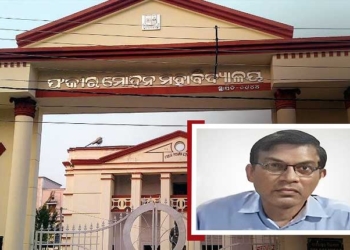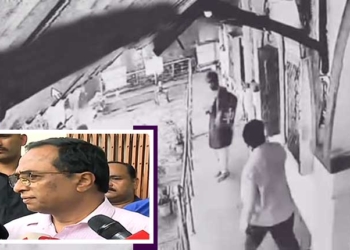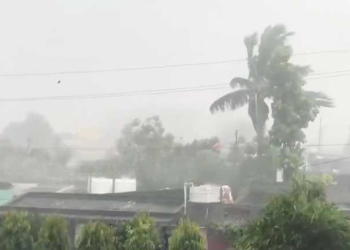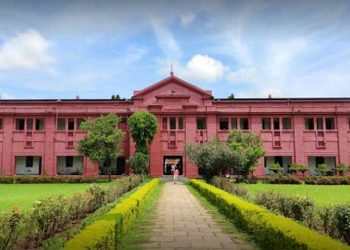Bhubaneswar: Finance Minister Niranjan Pujari today tabled Agriculture Budget for the financial year 2023-24 in the Odisha Assembly with a proposed outlay of Rs 24,829 crore with main focus on crop diversification and value addition in the agrarian economy.
Here are the excerpts:
The global economic prospects for 2023-24 appears to be grim. Both IMF and World Bank have forecasted a sluggish growth of around 1.7%. India is recognized as the bright spot in the world with projected growth of 6.8% during 2023-24.
Odisha’s economy with sharp recovery from the impact of pandemic with growth of 11.5% in 2021-22 and consistent higher growth than national economy has been the growth engine of the country.
With projected GSDP growth of 8 percent in 2023-24, Odisha can be one of the brightest spots of Indian economy.
With consistent higher economic growth, the per capita income gap at National and State level has narrowed down from 31.6 percent in 2015- 16 to 11.7 percent in 2022-23.
With this trend, we can expect the State per-capita income to surpass the national average in coming few years. In this context, I now proceed to present the Agriculture Budget.
Odisha is predominantly an agrarian economy with Agriculture and allied activities constituting 22.5 percent in Gross State Value Added (GSVA) as per Odisha Economic Survey, 2022-23.
The agriculture and allied sector is the largest single employment sector of the state and holds the key to socioeconomic development in the state.
Therefore, our Government lays special emphasis on development of the sector through various interventions supported by a comprehensive and inclusive State Agriculture Policy that has a paradigm shift with its orientation towards market linkage. It is expected to bring a substantial change in farmer’s income through realisation of better prices.
Our Government is supporting this sector through a separate Agriculture Budget since 2013-14 with allocation of a sizeable portion of its resources.
With an objective of increasing the production, productivity of both farm and the farmer and welfare of the farmers in State, I propose an outlay of Rs.24,829 crore under the Agriculture Budget, 2023-24 which is 20% more than last year and times of the Budget Estimate during 2016-17.
In line with the commitment of Hon’ble Chief Minister, Odisha that “It is my endeavour that not a single poor man is deprived of Food Security”, the State is implementing NFSA and SFSS in a transparent and efficient manner. In fact, our efforts have not only been appreciated across the Country but have been recognised by recently conducted State ranking index (2022) for National Food Security Act (NFSA) by Government of India wherein Odisha has been ranked as the No.1 State in the Country.
Food Security can be achieved by putting in place a robust paddy procurement system on the ground. In the last two decades from a food deficit State, we have not only become surplus but also are the 4th largest contributor to the Central Pool. Since paddy procurement operations are increasing and in order to ensure timely payment to the farmers, in this budget, there is a provision of Rs.2,000 crore as revolving fund to be utilised for paddy procurement operations besides the borrowings by OSCSC. Though paddy procurement operations are conducted in all the 30 districts of the State but major contribution is from the Western Odisha. So, they will be the major beneficiaries of the revolving fund and it will help them in their livelihood.
Krushak Assistance for Livelihood and Income Augmentation (KALIA) scheme has been introduced by the
State Government in the financial year, 2018-19 to accelerate agricultural prosperity and reduce poverty in the State. About 41.08 lakh small & marginal farmers and 18.69 lakh landless agricultural households have already been assisted under this scheme in the State. I propose an amount of Rs 1,879 crore is under KALIA scheme in the budget.
Crop Production Management: The Strategy for Crop Production Management in the State embodies smooth procurement and distribution of Agriculture Inputs (Seeds,Fertilisers & Pesticides) of desired quality and making them available at farmers’ doorstep in adequate quantities, timely and at affordable prices.
Odisha University of Agriculture and Technology (OUAT) plays a vital role in agricultural research and extension education in the State. Chief Minister has committed to transform OUAT into a Centre of Excellence and set global benchmarks in agricultural research and extension. Rs166 crore has been proposed as grants to OUAT for agricultural research, education, and infrastructure, which is more than five times of Budget allocation made in the year 2019-20.
Horticulture is one of the key drivers for economic development which provides income support to the farmers and improve their nutritional security. Rs 381 crore has been proposed under Horticulture Development Programme to stimulate an array of activities for the promotion of horticultural crops and holistic growth of the horticulture sector.
Similarly, Rs 121 crore is proposed under National Horticulture Mission for integrated development of horticulture.
Soil Health Management has assumed greater importance due to intensive agriculture practice. Organic farming is being constantly pursued under the aegis of State Organic Farming Policy and it is aimed to cover around 2 lakh hectares during next five years under organic farming.
Farm Mechanization has been one of the focus points of State Government. Rs 388 crore is proposed towards subsidy for capital investment for the establishment of commercial agrienterprises & for popularization of agricultural implements and diesel pump sets.
JALANIDHI Scheme has been remodeled as “Soura Jalanidhi” programme to harness renewable source of energy, especially in power inaccessible areas. 2902 number of Solar powered private lift irrigation points have been established. During 2023-24, it is proposed for bringing more area under assured irrigation and for the purpose, Rs 250 crore has been proposed under the scheme. Apart from that it is proposed to provide Rs 45 crore under State Incentive for Micro irrigation.
Further, Rs 306 crore has been proposed under Rashtriya Krishi Vikas Yojana (RKVY) to ensure the holistic development of agriculture and allied sectors in the State.
An allocation of Rs 52 crore has been proposed to support Farmers’ Producers Organisations (FPOs) in the production, aggregation, storage, processing, distribution, and marketing of agriculture and allied sector resources for sustainable development.
We would spend Rs. 367 Crore for next five years for implementation of the “Empowerment of Women in Agriculture- Promotion of Entrepreneurship for Women SHG” to ensure sustainable income generation of women beneficiaries / WSHGs to make the State a net exporter of mushroom & high value flowers over the mission period. An allocation of Rs 100 crore has been proposed under Mission on Floriculture & Mushroom.
Odisha Jackfruit Mission is to be implemented in 50 blocks of selected 9 districts of the state within 5 years. An allocation of Rs 9 crore has been proposed under the scheme.
Irrigation and Water Use efficiency: Our Government’s thrust on accelerated development of irrigation continues. In recent years, Chief Minister has dedicated to the farmers of Odisha big projects like Upper Indravati Lift Irrigation Project in Kalahandi, Lower Indra Major Irrigation Project benefiting Nuapada & Bolangir and Deo Irrigation Project benefiting the tribal farmers of Mayurbhanj & Keonjhar.
In the last two years, irrigation has been provided to an additional 32,000 hectares in Mayurbhanj and Balasore from Subarnarekha Irrigation Project. Another 10,000 hectares will be added this year from this project.
Pursuant to Chief Minister’s commitment to the people of Western Odisha, Gangadhar Meher Lift Irrigation Project was initiated in 2020 to benefit the farmers of mainly Bijepur, Sohela and Barpali of Bargarh district. This project, utilizing pipelines with diameter up to 11 feet, has been executed at record speed and will be completed before time, providing kharif irrigation to 25,600 hectares.
Further, impounding of water in reservoirs will take place this year in Lower Suktel Major Irrigation Project in Bolangir, and Kanupur irrigation Project in Keonjhar. Also, the link canal connecting Anandapur Barrage on Baitarani river to Bidyadharpur Barrage on Salandi River will be dedicated to the people of Keonjhar and Balasore this year. Further, Ghatakeswar dam in Ganjam, Manjore extension in Angul and Kusumi barrage in Nayagarh will also be completed in 2023.
With the objective of water conservation and to meet the ever-increasing demand for water, the Government had announced a scheme for Construction of Instream Storage Structures across various rivers in 2020. While, in 30 Instream Storage structures, work has been taken up, the Instream Storage Structure at Saptamatruka in Jajpur will be completed in June 2023. Apart from that, 16 more In-stream Storage Structures are being grounded this year in Jamutpali in Bargarh, Khairamal in Boudh – Sonepur, Subalaya in Cuttack – Nayagarh, Budlapali in Sambalpur, Sorada in Ganjam, Kansapal in Mayurbhanj, Akhuapada in Bhadrak, Deogaon in Sambalpur, Amath in Kalahandi, Kukedmal in Bolangir, Jenapur in Jajpur, Kursud in Kalahandi – Bolangir, Jokadia in Jajpur, Patharla in Bolangir-Kalahandi, Tustapali(Lower Lanth) in Bolangir and Godhaneswar in Sonepur-Boudh. In the coming financial year, another 20 Instream Storage Structures are proposed to be taken up including one at Khadago in Kandhamala fulfilling the long-felt needs of the region. For this an initial sum of Rs.854 crore has been proposed in this budget.
To cater to the needs of the hitherto uncovered upland areas of the state, our Government launched Parvati Giri Mega Lift Irrigation scheme. Under the scheme, 208 projects have been completed. In the 2nd phase, 170 new projects have been taken up with an estimated cost of Rs.10,759 crore over a period of 5 years which will provide irrigation to an additional 2.63 lakh hectares and a sum of Rs 500 crore has been proposed under this scheme.
Our Government’s Deep Bore-Well and Community Lift Irrigation Programme has received overwhelming response from over 16 lakh farmers in districts like Bargarh, Bolangir, Kalahandi etc. Under the scheme, more than one lakh deep bore wells and around 35,000 Community Lift Irrigation Projects have been completed. Considering its success, our Government has approved Rs.4,198 crore for installation of additional one lakh deep bore proposed during 2023-24 under the scheme with a target to install 20,000 deep bore wells this year. A sum of around Rs.400 crore has been proposed under Biju Krushak Vikash Yojana (BKVY) for taking up around 1500 Community Lift projects during 2023-24.
To address the concerns of the Members of the august House, under CM’s directions the revival of defunct lift irrigation points will be taken up as a drive to cover maximum number of defunct LIPs that are otherwise technically feasible for revival. An initial sum Rs 191 crore has been proposed to revive defunct Community Lift Irrigation Projects during 2023-24.
In the coming five years, our Government proposes to invest around Rs 75,000 crore for creation of water infrastructure to meet the growing needs of the people of the State. As a part of this initiative, this year, we propose to ground Nabarangpur Lift Irrigation Project in Nabarangpur to provide irrigation in Tentulikhunti, Nandahandi and Nabarangpur blocks; Upper Lanth Irrigation Project in Bolangir; Brutang Irrigation Project in Nayagarh to provide irrigation to 23300 hectares in Nayagarh, Khandapada, Daspalla, Odagaon & Nuagaon blocks; Samakoi Barrage Project in Angul district to provide irrigation to 9900 hectares in Pallahara, Kaniha & Telkoi blocks; Pipalpaka Irrigation Project in Ganjam to provide irrigation to 3200 hectares; Khairibandhan Irrigation Project in Mayurbhanj to provide irrigation to 6900 hectares.
Further, as committed, Government will continue efforts to complete new medium irrigation projects namely Sandul in Kalahandi, Sono in Mayurbhanj, Bankatira in Balasore and Turiguntat in Nabarangpur.
Under Mukhya Mantri Adibandha Tiari Yojana (MATY), more than 15000 check dams have already been constructed across small streams and nallas. Under version 2.0 of the scheme, another 1280 check dams are proposed of which 450 will be completed and another 450 will be taken up this year for which a sum of Rs 181 crore has been proposed under this scheme.
The Government has approved Mukhyamantri Disaster Resilient Saline Embankment Project. Under this scheme, around 200 km of saline embankments in Balasore, Bhadrak, Kendrapada and Puri will be strengthened with the technical support of National Institute of Ocean Technology, Chennai.
Strengthening of flood control embankments and drainage improvement works will be done in vulnerable areas for which a sum of Rs 961 crore has been proposed in the budget.
Under our Government’s scheme, Canal Lining and System Rehabilitation Programme (CLSRP), major canals will be lined including ongoing lining of Bargarh & Sason Canal of Bargarh and Sambalpur district, Upper Indravati Right Canal in Kalahandi district, among others. For this an initial sum of Rs 270 crore has been proposed.
Further, for modernization of irrigation projects, a sum of Rs.125 crore is proposed under Nabakrushna Choudhury Secha Unayana Yojana.
As transformational target using 5T principles, a sum of Rs 30 crore has been proposed for development of a Water ERP called GO-WATER for facilitating use of technology for proper assessment of water resources, flood forecasting, irrigation management and project monitoring.
Farm Credit: The State Government, in collaboration with NABARD, has launched a scheme titled “BALARAM” to extend institutional credit to sharecroppers especially landless farmers. The scheme envisages covering 5 lakh farmers through 1 lakh Joint Liability Groups (JLGs). 56,311 JLG groups have been formed and 12,394 farmers have been financed a sum of Rs.98 crore.
The Government is committed to provide interest free loans up to Rs 50,000 to farmers under the KALIA scheme. We have also kept our promise to provide interest subvention on crop loans above Rs 50,000 and up to Rs 3 lakh at an effective interest rate of 2 percent. Rs 836 crore has been proposed under the scheme Interest Subsidy/Subvention to farmers.
The Cooperatives are providing about 60 percent of the total crop loans dispensed to the farmers in the State as against the national average of 17 percent. Rs 30 crore is proposed towards financial support to Cooperative institutions and Rs 150 crore towards equity support to Cooperative banks.
Similarly, a Corpus Fund of Rs.100 crore has been provided for Odisha State Co-operatives Marketing Federation Ltd. towards procurement of non-paddy crops. Rs 200 crore has been proposed towards interest free loan for fertilizers and seeds.
Pradhan Mantri Fasal Bima Yojana (PMFBY) is being implemented in the State to provide insurance coverage to the farmers. An allocation of Rs.600 crore is proposed for settlement of the claim of the farmers.
Post-Harvest Management: The Price Support scheme has been introduced in the State through the involvement of NAFED to provide remunerative prices to the farmers for non-paddy crops namely green gram, black gram, arhar, groundnut, and sunflower. Further, e-Samridhi portal has been developed for the registration of farmers for procurement of pulses and oilseeds.
Odisha Millet Mission is a pioneering step which we started in 2017 for promotion of the climate resilient and nutritionally rich crops. The special programme implemented in the state for promotion of millets in a Mission Mode in 143 blocks of 19 districts during 2022-23 and it has been extended to 177 blocks spread over all 30 districts of the state for coming year 2023-24. The United Nations declared 2023 as the International Year of Millets. Odisha model of promotion of millets is now widely recognized and adopted by other states. Rs.497 crore is proposed for the Mission.
Allied Activities: Livestock and fisheries sectors have played a significant role in enhancing incomes of farmers over the last 2 decades in Odisha. Our government has identified the allied sectors as the growth propellers for Odisha’s farmers, women SHGs, and entrepreneurs, going forward. It is proposed to enhance the outlay of Fisheries & Animal Resources Development Department to Rs 1,769 crore.
Fisheries:Fisheries and aquaculture are playing a major role in multiplying farmers’ incomes, enhancing livelihoods, creating gainful employment, providing nutritional security and contributing to export earnings in the State. The Government is encouraging pisciculture, on a large scale, to enhance production and productivity. A provision of Rs 143 crore has been proposed for Intensive Aquaculture and Inland Fisheries Development.
Mukhya Mantri Maschya Jibi Kalyan Yojana an umbrella scheme with 17 number of components has been proposed with Budget outlay of Rs.210 crore aims at benefiting 50,000 fishers including 11,000 WSHGs directly and more than 1 lakh fishers with indirect employment generation during the current year.
An outlay of Rs 220 crore has been provisioned for renovation and up-gradation of Government Fish Farms.
It has been proposed for dredging of Devi River mouth at Astaranga and Mahanadi River mouth at Paradeep with provision of Rs.20 crore to make them navigable round the year.
An outlay of Rs 180 crore has been proposed under the scheme ‘Blue Revolution’ for integrated development & management of fisheries.
Animal Husbandry & Dairy: Animal husbandry and dairy have enormous potential for rural self-employment and women empowerment.
Rs 157 crore has been proposed under Poultry Development scheme to provide support for setting up of new broiler farm units, layer poultry farms in cage system, duck farms, backyard poultry units, mini poultry feed units and small-scale poultry hatches during 2023-24.
Over 300 farmers will be supported for setting up of small sheep and goat units & 2,200 WSHGs will be supported for setting up semi-commercial Goat units with a Budget Provision of Rs.29 crore during the year 2023-24. 130 farmers will be supported for setting up of piggery units with a Budget Provision of Rs.2 crore during the year 2023-24 for pig development in the state.
To provide support to existing Goushalas/construction of new Goushalas in urban and semi-urban areas, Rs.20 crore has been proposed during 2023-24.
A provision of Rs.120 crore under the scheme ‘Rashtriya Pashudhan Vikash Yojana-White Revolution’ has been made for the development of dairy and livestock management.
Rs.267 crore has been proposed under Livestock Health and Disease Control programme during 2023-24.
A sum of Rs.18 crore has been proposed for the Artificial Insemination Programme so as to improve the genetic quality of cattle for enhancing milk production.
Rs.194 crore has been proposed for infrastructure support and veterinary service delivery during 2023-24 for strengthening and modernization of Veterinary Hospitals and Dispensaries in a phased manner.
A separate Agriculture Budget was made in 2013-14 with an outlay of Rs.7,162 crore. However, under the dynamic leadership of Chief Minister, an outlay of Rs.24,829 crore has been proposed in 2023-24.
Agriculture is a fundamental source of rural prosperity. Agriculture can no longer aim at subsistence. It has to be a key driver for growth and poverty reduction. Hence, crop diversification and value addition in the agrarian economy will be the main focus.
















